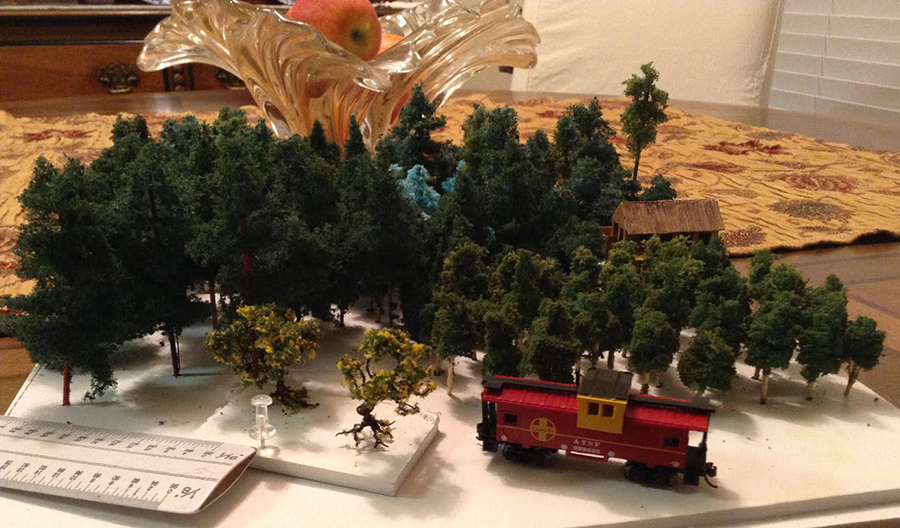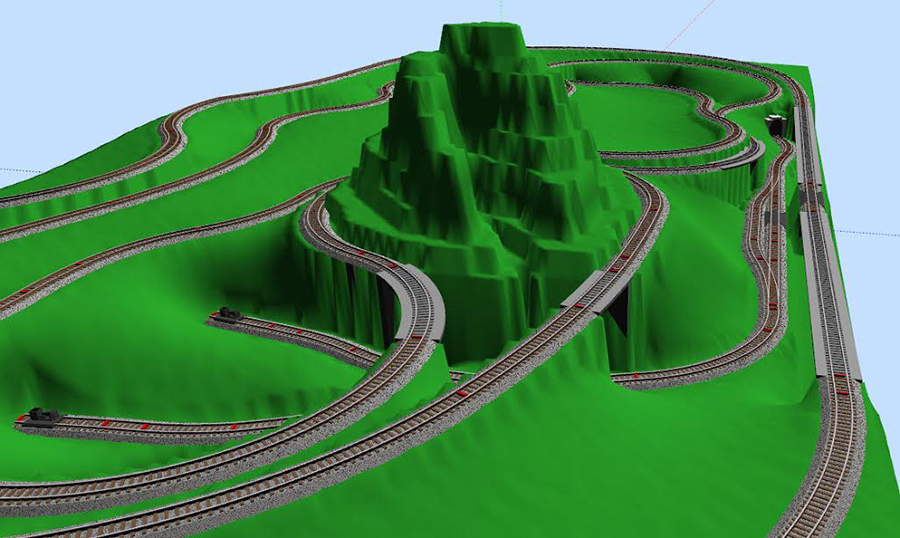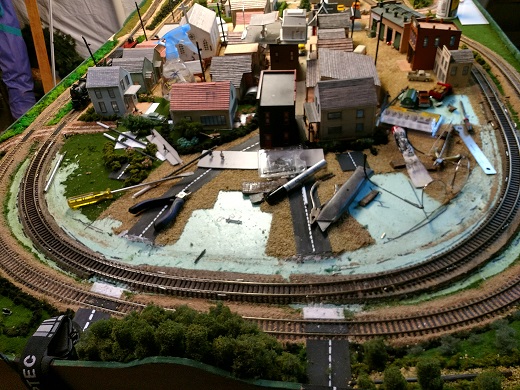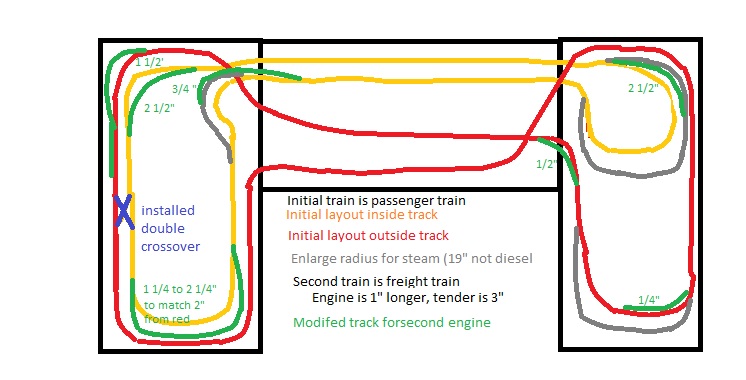Wayne’s been in touch added to the n-scale layouts on the blog:
“Just call me the Conductor of the Landen-Meyer Railroad.
Landen is my soon-to-be four year old autistic grandson, who, like me, lives near trains, and we hear and see them often.
I decided a few years ago that, since I had time (trains are for 14 year olds, I hear?), I would get started early.
So, I began to spend time making content for an N-scale railroad. Several hundred trees, buildings, outhouses, a bridge or three are under construction.
Also, since I had no prior experience doing a model like this, I began doing little studies.
The idea in mind is an 1800’s abandoned gold mining district, and nothing in it is a “new” building, so I make them from scratch using those little cedar wraps that you soak and use on the barbeque. Trees are wire armatures, various colors, brands, and manufacture dates (composition varies), of abrasive scrubber pads glued in tree-fashion onto the remains of incense sticksbecause theysmell nice.
Rocks are plaster casts and some sculpting (when I get there).
Here are some photos:
My first caboose and many trees (more now- this was almost two years ago).
The scale in the foreground has been replaced by a model railroader’s scale.
Executive outhouse studies.
One has a handicap ramp.
6inch (16cm) square Basic Concept- nothing but wood, abrasive-pad trees, acrylic color, and plaster in this one. Water in the hot tub needs to be changed.
As far as an actual TRAIN was concerned, for these past two years, all I had was that caboose. Sad, I know.
I’ve been told I do things backwards. So I finally got a small 24″ dia. set last Christmas (funny how that works) and some polystyrene packing blocks from a desk I bought:
The base is a 30 inch square (76 cm) piece from a left over hollow core door blank. Sides will be finished in luan panels along with that clever idea for a cover having pneumatic pistons to operate. It’s a start, anyway.
The idea is to encourage interest. Eventually, (I did say I have another ten years) this piece will be nestled into a larger layout with more trains
This is a photo of the “switcher tracks” centerpiece for part of that layout:
N-scale layouts:
Kennecott Mill, AK.- abandoned, not quite fully 1800’s but a lot of character.
I have scoured the inter-webs over the last two years for abandoned buildings and have quite a collection to
exploit. Mine tunnels, Head frames, water-cannon mining, panning, dredging, and sluicing are all planned to be included.
If you like, I’ll keep you posted.
Be advised though, this is a long term investment.
But you all already knew that… 😊,
Finally, I often see questions about layouts by other N-scale layouts enthusiasts, but I have not seen any reference on your website regarding computer software for railroad modeling.
I offer the two that I know of:
The first is a freeware provided by Atlas:
https://shop.atlasrr.com/t-software.aspx
The second is a more robust version by SCARM:
https://www.scarm.info/index.php
This version is like Atlas’, but has a more thorough library of track manufacturers in it.
Purchasing the full version is reasonable, and gets you more goodies. Buildings are very primitive though.
Both offer terrain modeling, bridges and tunnels, track incline tools and a 3D viewer of your masterpieces.
Neither are particularly computer-intensive or difficult to use, but you need to experiment to understand them.
Here’s a screen shot of some N-scale layouts study:
Thank you for your support of my grandson’s new hobby.
I hope this interests and encourages others.
Wayne”
A big thanks to Wayne for adding to the N-scale layouts collection. Quite a few on the blog now!
“Hi Alister,
I enjoy reading your wide range of posts for the modeling railroad community.
I thought the fans of older steam engine kits might enjoy my rebuild of the Penn Line HO K-4 Pacific.
I originally built the kit in the late 50’s, and upon leaving for college, what little HO running stock I had was boxed away. A couple of years ago (now in my 70’s)I decided to rekindle my interest in an HO layout, and began by disassembling the old K-4 (I still had the original assembly manual and hex wrench for the drivers), stripping the paint from the metal castings, pickling in boiling vinegar, and spray painting with semi-gloss Krylon grill paint.
The soft iron hand rail had rusted, but all of the small brass stanchions were still in place. I removed the rail, straightened it, and removed the rust with 4/0 steel wool. After degreasing, I blued the wire with Birchwood-Casey paste gun bluing and polished to a high blue/black polish. I resent the rail to the original pattern (much better that I did when 15) and reinstalled.
I made the coal load for the tender by placing a piece of plastic wrap in the tender well, filling it with fine synthetic coal, and wetting with the classic 2:1 70% isopropyl alcohol:Elmers white glue mixture. After drying, I removed the coal load and gently peeled off the plastic; worked well.
I had to remove the motor and polish the oxidized commutator, held in a mini-drill press with a loop of 1200 grit wet-or-dry (dry!) automotive paper. While not modern by any means, the old DC worm drive motor powers her around the layout quite smartly!
Enjoy,
Rob”
“Take a track cleaning car and clean the cleaning pad with TRANSMISSION FLUID! Leave just a very light coating on the pad then run the car over the road. This will not only clean the track but leave a thin film of fluid on the track to keep the track clean.
Moreover a quart bottle of fluid should be a lifetime supply for a very reasonable price!
Martin”
And Lawrence has been in touch again (his last post is here):
“Hi Al
Thought I would give an update on my track. But first I want to say I really envy those out there that have been doing it for years and have lots of trains, houses, people, and autos. And that have rebuilt their layouts more than once. Now to explain why.
I started from nothing and with a little research built a design that would work with the track and scenery I wanted. Built the table, laid the foam base and foam for mountains and rail risers (not knowing any better used the four-degree store bought items). Then I put the track down (refer to the attached picture, red and orange) and put the electrics for the track installed for DCC.
Then I decided I could afford a DCC passenger steam engine and tender (4-6-2). Had DC diesel engines and cars from when I was a kid. Found out that the steam radius is 19” minimum and not the 15” minimum of Diesels. Refer to the grey on the picture where I tore up the track and adjusted for steam. And ran the train for an hour in each direction without any derailment. YIPPEE
Affording a little at a time I worked on the scenery. Scratch building the 400 trees and most of the buildings. Used a couple plasticville houses from old set. Got to the decision on getting a new train or the water for the lake and river. The water won out. Used Deep Water as the rivers were from half to three quarter inches deep and the lake was three quarters deep = fifteen packages of the deep water.
Now the next interesting (frustration to the maximum) part. I wanted a freight engine and tender. When I could finally afford it, got it (4-8-2). Ran it on the tracks *&^%$#*&^%. It derailed on almost every arc. The engine is one inch longer and the tender is three inches longer. The traction wheels are smooth. Going up the four percent grade it could pull ONE car before slipping. Ordered the Bullfrog Snot.
In the mean time I tore up all the track shown in green on the picture. Now was also the time to install the 2 right hand switches, 2 left hand switches and the crossover. That means also the scenery in those area torn up. Spent a LOT (really a great amount) adjusting the track (sometimes one eight of an inch) to prevent an engine or tender derailment. Ran the engine (with and without power) across the track to find any kinks or curves too sharp.
The Bullfrog Snot came in and applied two coats on the traction wheels and now it can pull six cars up the hills before slipping and any amount on the flats. And just got all the track adjusted and ran both trains in both directions for over an hour without any derailments. YIPPEE And no problems with the double crossover at all. Again YIPPEE
Now I can go back and fix all the scenery that I destroyed in the process and on to the lights.
Lawrence”
A huge thanks to everyone for today’s post, especially to Wayne for adding to the N-scale layouts.
Please do keep ’em coming.
And if you want to join in the fun, the Beginner’s Guide is here.
Best
Al
PS Thank you for all the comments on the new ebay cheat sheet – glad I updated it.











The Kennecott mill is impressive, we went in 1996 and I recognized it before I read your description. The completed layout should be outstanding!
What size is the layout.
Re: Waynes layout, during the late 50s – 60s I was stationed at Travis AFB in Calif. On weekends a few of us would go to a small town beyond Grass Valley called North San Juan and pan for gold. On the road there we would pass under sections of wood troughs that carried the water for Hydraulic Mining before it was outlawed. These troughs brought water from high elevations to lower where the actual mining took place. The drop in elevation provided the force, thru hoses, to remove the soil from the bedrock. Some of these “sluice” troughs were miles long. Just a thought that one of these would add authenticity to a mining camp layout. Haven’t started a layout, may not, but if I do it will be of an area such as that. Jim
Wayne, the time you will spend with your grandson is something you will both remember and cherish “forever”… i say “BRAVO” to you for being such a great grandpa !
Dave, in NY
Really fantastic stuff today..
Important ideas and impressive work
John from Cali
Ahhhh, The beginnings of a great layout – Thanks for the pictorial views and text story of such a great job well done. As so many have said before…. Quote, “No Layout is ever finished as there is always something else to be done, added, or worked upon, no matter how much you think the project is finished”. Unquote. Anywy, many thanks Wayne. Keep up the great work, and I hope to see more pictures of it in the future.
Thanks, all, for your kind words.
We’re having a great time with it; this endeavor takes lots of thought, so I love getting suggestions. I’ll look into North San Juan. I know exactly what you’re talking about. There might be some old pictures somewhere.
(you didn’t take any, by chance?)
re: layout size-
Those track softwares are addictive. I highly recommend them.
I’ve worked up a lot of 36×80 (92cm x 204cm) layouts in them before I got this idea of incremental bases.
The mill base will be a 30×42 (77cm x 108cm) switching game.
Eventually all of it will sit in portions of a 48×96 (122cm x 244cm) overall layout. (I figure if it takes that long, I might as well make some progress sets.)
The complete layout will have that little Bachmann Durango-Silverton n-scale as the outer loop, the Kennecott Mill switching game, and the 30×30 base I’m presently working on.
I’ll make a layout to share when I can get to it.
I found the images of abandoned buildings at Bodie, California to be very helpful for ideas and designs from that period. Although not a railroad integrated town… what remains speaks volumes of the hardships that were endured.
Best wishes,
Joe
There’s no doubt it all your contributers are such an impressive lot. Their information is presented in a timely and educational manner which is so understandable (especially with pictures) even a novice is able to grasp the concept.
You will never regret the time you spend with your Grandson so enjoy it as much as you can get !
I would say you are doing great work on the trees but you need to add some ground cover to the grassed parts so it does not shine like a flash lite in the dark does , just my opinion guy but you might want to check it out !
be well and stay safe Sir !
George
Looks interesting.
Have never seen a double decker outhouse. Sure wouldn’t want to be in the lower one if the upper one springs a leak.
just a great blog plenty to learn from. some great ideas to use. some nice photos.and good stories thanks for sharing.
Thanks for your posts Guys! enjoyed every one.
Anyrail 6 is another program for designing layouts and there are quite a few YouTube videos that show how to use it. And the basic version is free to get a feel for it.
Great posts today; lots of useful information and ideas.
Wayne,
Love the double-decker outhouse! 🙂 Also the 30 x 30 base for the mining camp. Sound like an ambitious project to keep you and the grandson busy for many years.
Rob,
So delightful to read and see the fine results of your K4 rebuild. It’s nice to see the old engines still being appreciated.
Lawrence,
You’re doing great. Sure you’ve made some mistakes, but that’s part of the fun of a model railroad. It can always be ripped up and redone to meet new requirements.
Al, Thank you once again for making this blog possible. You’re the greatest!
Looks awesome keep the good work. I hope mine comes out that good.
For an authentic multi-story outhouse, try old Fort Wayne in Detroit. It is just off the barracks, is three stories tall, and ranked for rank. Officers used top floor, etc. It is memorable!
Re executive outhouse, where does the executive sit? On the bottom would be best. Karma, you know.
Yep, there’s gold in them thar hill!